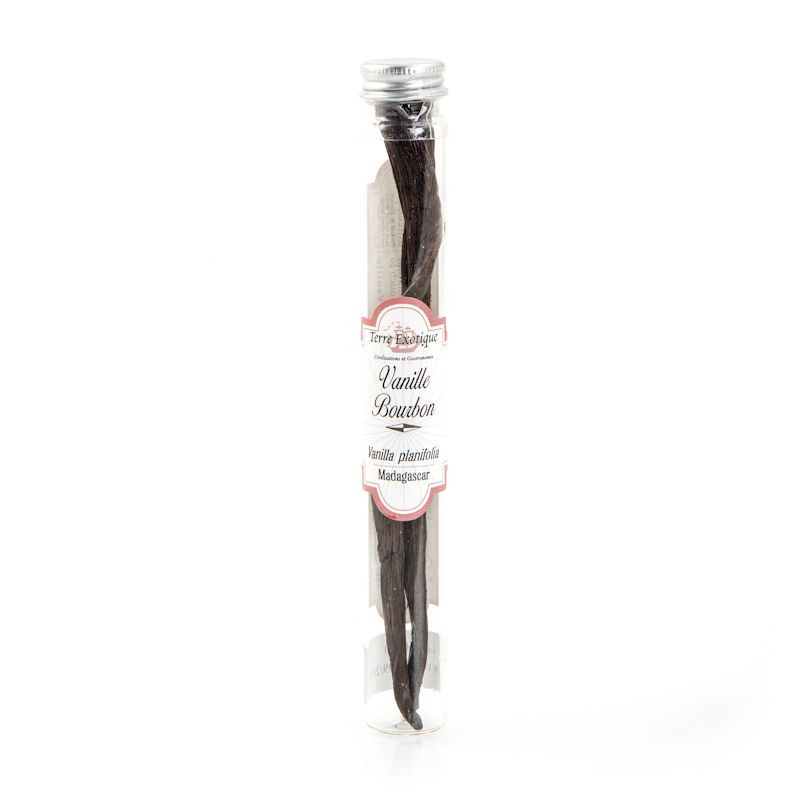

Order by 4 pm = delivery the next working day.
From CHF 100 purchase


Cut the pod in half and add to milk for puddings and creams or make your own vanilla sugar. Use the precious seeds to flavor a butter to sweeten fish and shellfish. With these vanilla beans you give dough, creams and fillings a delicious, uniform and natural flavor and subtle color.
Data sheet
In Madagascar, wonderfully aromatic Bourbon vanilla is planted and harvested. Through their entirely natural processing, the flavor is intensified and so already two pods are enough for a large amount of desserts.
Due to their versatile use, there are also various possible treats that can be conjured up from the noble pods. If you want to get everything out of your vanilla bean, it is best to start by using the seeds. To do this, flatten the pods with the side of a knife and cut them open lengthwise, then simply scrape out the seeds with a pointed knife. You can use them to flavor a butter that can be used to sweeten fish and seafood, or you can add them to a chocolate filling.
The remaining pods are then placed in a tall jam jar and covered with fine sugar. You have already created your own vanilla sugar, which has a long shelf life and gives many pastries and desserts a pleasant sweetness as well as a wonderful aroma. When the pods have released most of their aroma to the sugar after some time, you can take them out and boil them in milk. With this you can conjure up a vanilla cream or simply enjoy them with a little honey.
Vanillia Planifolia is an orchid whose cultivation requires constant attention and much care. It is the only edible orchid known in botany. The white flower grows at the end of a vine supported by a tree, usually a mango or avocado tree. The plant does not bloom for the first time until three years after germination, and is carefully pollinated by hand on plantations. Depending on location, vanilla beans take between six months and a year to fully ripen. They are still green and resemble beans. Only through drying, cooking and steaming they get their black coloring, the wrinkles and their wonderful aroma.
In the whole world there are less than ten known varieties of vanilla. It is found in Mexico, Uganda, Tanzania, Madagascar and Tahiti, and all differ in taste. The latter also has a slightly different growth habit, its pods being the only ones that do not split. The Bourbon vanilla selected by Terre Exotique comes from a high quality harvest. Bourbon vanilla is probably the best known and most popular variety thanks to its strong flavor.
The flavor of the beans comes from vanillin, an aromatic aldehyde that appears as a white crystal. The higher the vanillin content, the stronger the flavor and aroma of the pod. Bourbon vanilla, also called Madagascar vanilla, is characterized by its milky chocolate aroma. It carries floral and light roasted aromas, offering a variety of flavors.
To keep the vanilla beans in the best conditions:
- Before opening: store in a dry place.
- After opening: Put the pods in the refrigerator to prevent them from drying out.
The most famous recipe: crème brûlée with bourbon vanilla
Add 1 sliced and scraped vanilla bean to 4 dl milk and 4 dl full cream, bring to a boil, then blanch 8 egg yolks and 100 g sugar. Mix the two masses carefully and pour into small molds. Bake for one hour at 100°C. If desired, you can caramelize them with brown sugar.
Vanilla originated in Mexico, where the Aztecs used it to soften the bitterness of chocolate. This "black flower" was introduced by Cortes in 1521. Later, Louis XIV fell in love with it and wanted to grow it on the island of Bourbon, on La Réunion as it is called today. The vine bloomed but did not bear fruit because it had to be fertilized by a wasp that only existed in Mexico.
No one knew how to pollinate them. It was not until 1850 that Edmond, a young Bourbon Island slave, figured out the process by pricking and shaking the flower. In gratitude, he was set free, and the young man adopted "Albius" as the name of freedom, in reference to the white color of the orchid. The cultivation of bourbon vanilla became possible!
| Energiewert in kJ | 1205 kJ |
| Energiewert in kcal | 288 kcal |
| Fett | 0.06 g |
| davon gesättigte Fettsäuren | 0.01 g |
| Protein/ Eiweiss | 0.06 g |
| Salz | 0.00 g |
| Kohlenhydrate | 12.70 g |
| davon Zucker | 12.70 g |
Allergens
 Vanilla cornet recipe
Vanilla cornet recipe
 Making vanilla cream at home
Making vanilla cream at home
 Granola recipe
Granola recipe
 Crème brûlée
Crème brûlée

Cut the pod in half and add to milk for puddings and creams or make your own vanilla sugar. Use the precious seeds to flavor a butter to sweeten fish and shellfish. With these vanilla beans you give dough, creams and fillings a delicious, uniform and natural flavor and subtle color.